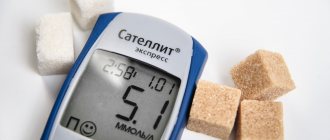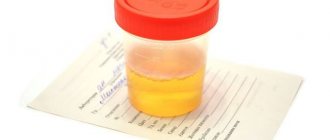The blood sugar level after eating is exceeded. And if insulin “does not cope” with its task (due to insufficient amounts of the hormone, or for other reasons), then the concentration of glucose in the blood above normal remains for a long time. Over time, this causes damage to blood vessels, nerve fibers, as well as cells and tissues of the eye, kidneys, etc.
If the norm for glucose in the blood remains exceeded for a long time, this leads to the development of diabetes. This disease requires constant regulation of blood sugar with the help of medications and diet, since the body itself cannot cope with this function.
In the case when the glucose concentration, on the contrary, is reduced, this condition is called hypoglycemia. Low blood sugar can also lead to disorders of the metabolism, nervous system, etc.
People with diabetes who use insulin injections are susceptible not only to increased glucose concentrations, but also to hypoglycemia. Both of these conditions can be dangerous to their health and life, so early diagnosis of diabetes and regular checking of blood sugar levels is very important. There are several types of tests for this.
Indications for use
If a patient exhibits symptoms similar to the characteristic features of diabetes mellitus, the doctor prescribes a sugar test. These symptoms include:
- decreased visual acuity;
- decreased level of performance, feeling of frequent fatigue;
- feeling of constant thirst;
- feeling of dryness in the mouth;
- rapid weight loss;
- itching and dry skin;
- frequent urination;
It is also recommended to take the test once a year for people at risk. These include:
- patients who have relatives with diabetes in their family;
- overweight women, men and children;
- women who gave birth to a child weighing more than four kilograms;
- patients taking glucocorticosteroids;
- people with tumor diseases;
- men and women who were diagnosed with heart or vascular disease in middle age.
Pregnancy is also a reason to examine the amount of monosaccharides in the body, since during this period there may be cases of hidden diabetes.
Symptoms of hypoglycemia
The decrease in sugar in the bloodstream occurs gradually or develops sharply. The clinical manifestations of hypoglycemia depend on the rate of decrease in the volume of the substance. Among the characteristic symptoms of the condition:
- anxiety syndrome, fear;
- increased irritability, aggression, apathy towards other people;
- general malaise, weakness, rapid fatigue;
- increased sweating;
- development of arrhythmia;
- trembling of hands and feet;
- impaired coordination of movement and speech;
- pale skin;
- nausea and vomiting syndrome;
- headaches, dizziness;
- impaired sensitivity of the tongue and lips.
In the absence of first aid and further treatment, the general condition gradually worsens, and a complication such as hypoglycemic coma occurs. The latter is characterized by loss of consciousness, severe muscle hypotonia, pronounced pallor of the skin, increased sweating, and convulsive syndrome.
When nocturnal hypoglycemia occurs due to incorrect administration of the hormone insulin, the following clinical picture is observed:
- nightmares in sleep, screaming in sleep;
- increased sweat production;
- feeling of lack of sleep, malaise after waking up.
With the long-term development of diabetes mellitus, experienced diabetics do not have obvious symptoms of impending hypoglycemia. Although the patient himself may not notice them, they are visible to others: the diabetic becomes irritable or, on the contrary, lethargic.
Survey objectives
The analysis is intended to detect the presence of diseases of various origins, be it diabetes mellitus or the presence of a tumor. In addition to diagnostics, the analysis results are also used to prevent the occurrence of diseases. That is why this analysis is performed in completely different cases when an adult visits a doctor.
In addition, there are several types of blood glucose testing:
- General blood analysis. It is not the amount of sugar that is examined, but rather the emphasis is placed on the level of hemoglobin and blood clotting.
- Glucose tolerance test.
It takes about two hours:
- Initially, blood is taken before eating;
- then the subject drinks an average of 100 ml of sweetened syrup;
- Then blood is donated three more times: after an hour, 1.5 hours, and the last draw - after 2 hours.
If the pancreas is functioning normally, the glucose readings will be elevated during the first sampling, and will decrease with each subsequent result. This analysis is carried out when the purpose of the study is to identify prediabetes, as well as the possible presence of latent diabetes in a pregnant woman.
- Analysis for glycated hemoglobin. Shows hemoglobin, whose molecules interact with glucose. So, with an increased sugar content there will be more glycated hemoglobin.
- Also, the purpose of the study may include changes in glucose per day. With this method, the algorithm for changing a person’s sugar readings is controlled.
- There are situations when there is no time to wait to go to the clinic, and the analysis needs to be done quickly. In such cases, the express method is used. It is carried out using a glucometer. Mainly used to control sugar status in diabetic patients. The advantage of this method is that it is fast. Disadvantage - possible difference from the results obtained in a laboratory test.
What is diabetes mellitus
This problem has plagued humanity for more than 3,000 years. According to WHO definition, diabetes is a group of metabolic disorders characterized by elevated levels of glucose in the blood, resulting from impaired insulin production, problems with its action, or both factors together. The result of a prolonged increase in sugar levels is various disturbances in the functioning of many organs and systems.
Symptoms
Before the development of laboratory diagnostics in medicine, the only signs by which doctors could suspect diabetes were:
- thirst;
- increase in daily urine volume;
- sugar in urine;
- increased appetite;
- specific smell from the patient.
As life expectancy with diabetes has increased, the number of complications has increased. How the consequences of the disease can develop:
- blindness, 25 times more common than usual;
- kidney damage with subsequent development of renal failure;
- diabetic foot syndrome, from small ulcers to amputation;
- coronary heart disease and its complications (heart attacks, strokes).
How to prepare
In order for the analysis results to be reliable, the patient needs to know that the examination requires certain preparation:
- Blood donation occurs on an empty stomach. The last meal should be 8 hours before the start of the procedure. Therefore, the most convenient time is morning.
- It is forbidden to drink anything except plain water.
- In two days you need to eliminate fatty foods and alcoholic drinks.
- On the day of delivery, you should not brush your teeth or chew gum.
- It is prohibited to take medications 3 days before the test. This is especially true for glycemic medications. If it is impossible to cancel, then you need to inform your doctor.
- Avoid smoking on the day of delivery.
- Do not subject the body to increased mental and physical stress during the day.
- The analysis does not fail after the patient has had a massage, x-ray, or ultrasound.
- You should not donate blood if there are signs of inflammation and infection.
It is important to follow all these rules, because the amount of sugar may change. Certain foods, physical activity, and possible stressful situations can increase or decrease blood sugar.
Before donating, some patients try to reduce the monosaccharide readings in the body using folk remedies. Such actions are unacceptable, since the real picture of the condition is distorted and the results will be invalid.
Blood sugar and type of diabetes
However, it is impossible to determine the type of diabetes (first or second) by the sugar level. The type of disease is not related to the result of the analysis, but to the causes of the pathology:
- Type 1 diabetes is the most severe form, occurring in 10% of cases. It is an insulin-dependent pathology, when the main cause is associated with insufficient secretion of the hormone insulin. Treatment is lifelong injections of this substance with constant monitoring of sugar.
- Type 2 diabetes is a less severe form and occurs in 90% of cases. This is acquired non-insulin-dependent diabetes. It is due to the fact that cells perceive insulin worse, which is why glucose does not penetrate into them and remains in the blood, which leads to an increase in levels.
Both forms of the disease are fraught with danger to the health and even life of the patient. If you do nothing, your health will worsen, which may lead to adverse consequences:
- destruction of blood vessels;
- serious metabolic disorder (ketoacidosis);
- heart attack;
- stroke;
- problems with vision and hearing;
- coma;
- limb amputation;
- bacterial and fungal skin infections;
- impotence.
Decoding the results
Laboratory specialists interpret the results. They write them on special forms and then give the data to the doctor. The designation of sugar in the form with the result of a blood test is a combination of three letters - GLU.
Normal indicators
Blood glucose levels are presented in the following table:
| Age | Normal indicators |
| Newborns | 2.9-4.4 mmol/l |
| From 1 year to 14 years | 3.4-5.6 mmol/l |
| 14-40 years | 4.1-6.2 mmol/l |
| 40-60 years | 4.4-6.5 mmol/l |
| 60-90 years | 4.6-6.7 mmol/l |
| Over 90 years old | 4.6-7.0 mmol/l |
The table values show the results obtained when donating blood from a finger prick. The result of an analysis using venous blood is influenced by factors such as the gender and age of the person. Therefore, in men the levels can be from 4.2 to 6.4 mmol/l, and in women – 3.9-5.8 mmol/l.
What does a urine glucose test indicate?
- Normally, sugar is absent in the urine or is excreted in the urine in minimal quantities (less than 0.8 mmol/l), since all glucose is reabsorbed from the primary urine in the renal tubules.
- Glucose penetrates into the urine only when its concentration in the blood exceeds 10 mmol/l.
Mild glucosuria may occur during pregnancy. In addition to various types of diabetes (mellitus, renal, steroid), glucose in the urine can appear in myocardial infarction and ischemic stroke of the brain, polytrauma, prolonged compartment syndrome and massive burns. Most of these conditions are critical care and do not require routine testing on an outpatient basis.
Additional test
A glucose tolerance test is indicated for pregnant women. Doctors associate diseases such as sclerocystosis and hormonal imbalances with impaired sensitivity of the body to grape sugar. The test is carried out as follows:
- Venous blood is collected on an empty stomach.
- The patient dilutes 75 grams of glucose in 200 ml of water and drinks. An unpleasant overly sweet taste can be corrected with lemon juice.
- After 1 hour, the woman should drink another 1 glass of water.
- 2 hours after the start of the test, venous blood is taken again.
General information
Glucose metabolism in the body is regulated by two main hormones: insulin and glucagon. The action of these hormones is opposite. Maintaining blood sugar at the same level is extremely important, so the concentration of blood glucose is constantly monitored by special cells of the pancreas. These same cells release the necessary hormone into the blood.
After a meal, when blood glucose levels rise, insulin is activated. It acts as a key for glucose and thereby helps it “enter” cells that need energy. Insulin also stimulates the use of glucose in tissues and promotes the formation of glycogen. Glycogen is a substance in the form of which the human body stores excess glucose. As a result of the action of insulin, blood sugar levels decrease. If this link in carbohydrate metabolism is disrupted, diabetes mellitus occurs, a disease in which blood glucose levels cannot decrease.
Glucagon works when blood sugar levels are low. Glucagon stimulates the release of glucose from the body's stores so that cells can get the energy they need from it. Glucose is especially necessary for the brain, since it is the only source of energy for it. As a result of the action of glucagon, blood sugar levels increase.
How to measure blood sugar at home
A blood glucose test can also be performed at home. For this you need a special device - a glucometer. To correctly measure glucose levels, a number of conditions must be met:
- Blood sugar measurement is carried out on an empty stomach; before the procedure, you must thoroughly wash your hands with soap and dry them with a towel.
- To measure, a special test strip is used, which must be inserted into the opening of the glucometer. After this, a symbol will appear on the glucometer indicating that the device is ready for testing.
- Next, a needle or scarifier is used to puncture the skin of the nail phalanx of the ring finger. It is not necessary to treat the skin with alcohol before piercing, but if you do this, you must wait until the antiseptic has completely dried, because residual alcohol may distort the readings.
- As a result of a puncture of the skin, blood appears, but you cannot press on your finger; the blood should flow out on its own. The first drop of blood is wiped off with dry cotton wool. As the blood flows out, a second drop is formed, to which the test strip inserted into the glucometer is brought. The test strip itself absorbs the amount of blood that is needed for the test. After a few seconds, the glucometer displays the test result in mmol/l.
- After the measurement, the used needle and test strip should be thrown away.
Glucose - chemistry and anatomy
Glucose is present in fruits and vegetables.
Glucose is a monosaccharide that is present in fruits and vegetables. Historical name: "grape sugar". In appearance it is a white crystalline powder with a sweet taste.
When paired with another monosaccharide, fructose forms a well-known and widely consumed sugar. In addition, glucose is part of many complex carbohydrates.
This monosaccharide is a universal source of energy for plants, animals, and humans. It ensures metabolic processes in the body. It is the increase in the level of this sugar in the blood that provides a person with a feeling of fullness after eating.
So they ate candy - a fast carbohydrate - glucose rushed into the blood. I don't want to eat. For a while. Then everything repeats again. My sugar level dropped and I wanted to eat. You ate and feel good. But all processes in the body must be in balance. Including the rate of absorption and processing of carbohydrates. The pancreas regulates the processes of glucose absorption.
It is the largest endocrine gland in the human body. The organ produces the hormone insulin, which ensures the normal breakdown and absorption of grape sugar. But, according to statistics, people have sharply increased their consumption of carbohydrates over the past 20 years. Let's add stress and unfavorable environmental conditions. The load on the pancreas increases and at some point a failure may occur.
How much glucose should there be in the blood? Find out from the video:
https://www.youtube.com/watch?v=Eqrg24QtnA0






